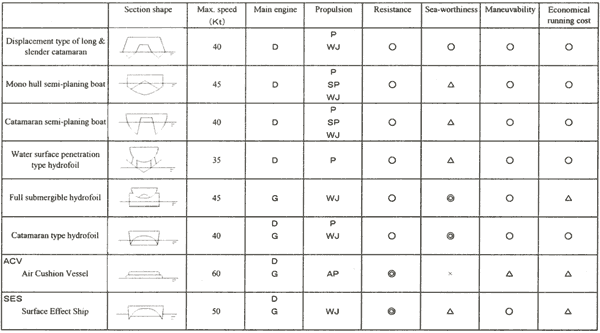|
<Table 9>
Cobalt Arrow 5
Lwl=33.0m
Light alloy W=95.00 ton
Steel W=118.67 ton Difference of displacement=23067 ton
Difference of horsepower between light alloy and steel
| Speed (Kt) |
18 |
20 |
22 |
24 |
26 |
28 |
| Horsepower (PS) |
417 |
491 |
582 |
681 |
778 |
887 |
|
Fuel Consumption: Light alloy vs. Steel
| Speed (Kt) |
23 |
24 |
25 |
26 |
27 |
28 |
Fuel
Consumption
(L/hr) |
Steel |
581.1 |
622.4 |
668.9 |
708.6 |
756.6 |
800.1 |
| Light alloy |
452.4 |
487.5 |
522.6 |
557.7 |
592.8 |
626.0 |
| Difference |
128.7 |
134.9 |
146.3 |
150.9 |
163.8 |
174.1 |
|
On 35-meter ships, the weight of the steel and aluminum hull differs by 23.67 tons. Assuming that one person weighs 60 kg, it means that the aluminum ship adds to the displacement equivalent to 461 people. Since the horsepower also differs by about 600 p.s. and cost of F.O. will be different so much, less high tensile steel ships are being used now. The cost of material is different, but the building costs are almost same between the two types.
6. Comparison of high-speed vessels
<Table 10>
Comparison of High Speed Vessels
(Enlarged Image:35KB) |
 |
Main engine: D: High speed diesel, G: Gas turbine
Propeller: P: Underwater propeller, WJ: Water jet, SP: Surface propeller, AP: Air propeller
The top three are the displacement type, semi-planing type, and planing type. This table compares the seaworthiness, maneuverability, and economical efficiency.
Water surface piercing type hydrofoil, full submergible hydrofoil, and catamaran hydrofoil are designed focusing on riding comfort by lift of the hydrofoil at the bottom of the ship, and water contact areas are reduced to limit the lower resistance and minimize the impact of waves in comparison with planing type. With ACV and SES, air is sprayed to the water surface to lift the vessel by air pressure. Reducing resistance, this allows high speed and reduced wave impact.
|